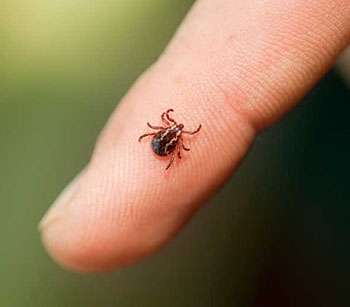
Ticks and tots: How to safely enjoy the outdoors this summer
After being cooped up for more than six grueling winter months, kids are finally free to go outside and enjoy summer. While there are many fun, family activities to enjoy throughout the city and state, there is one pest to be aware of – ticks.
Unfortunately, these pesky bugs can be just as big a part of summer as barbecues and baseball. According to the Centers for Disease Control and Prevention (CDC), Wisconsin saw a record 4,299 cases of Lyme disease in 2017, putting it in the top five most active states. All across the United States, cases of bug-borne illnesses have more than tripled since 2004.
The good news is awareness goes a long way and the best treatment is prevention.
What is Lyme disease?
Lyme disease is a bacterial infection that is transmitted through bites from deer ticks. In 70-80 percent of cases, the telltale sign of Lyme disease is a bulls-eye rash — a central, circular red spot surrounded by one or more red circles. Other early symptoms include fever, chills, headache, fatigue and muscle and joint pain (similar to early flu symptoms).
While most tick bites — as high as 95 percent — will end up being completely harmless, it’s important to know when medical attention may be necessary. If your child recently spent time outside and is experiencing any of the above symptoms, call your child’s pediatrician right away. If a diagnosis is confirmed, a 10-21 day course of antibiotics will cure most cases.
If left untreated, Lyme disease can worsen to include pain or numbness in the joints and extremities, paralysis of the facial muscles, irregular heartbeat and inflammation of the brain and spinal cord. And the longer the infection goes untreated, the harder it becomes to get rid of.
The DEETs on bug spray
 The first step everyone should take against bugs is insect repellent. You should apply an insect repellent to you and your family anytime you’re going to be spending prolonged time outdoors. Look for products that contain DEET, Picaridin or IR3535. These ingredients are effective against ticks and other biting insects like mosquitoes and flies (but not stinging insects like bees or hornets). Also, I recommend you use lotions or pump sprays — avoid aerosol sprays as they increase the risk of inhaling chemicals.
The first step everyone should take against bugs is insect repellent. You should apply an insect repellent to you and your family anytime you’re going to be spending prolonged time outdoors. Look for products that contain DEET, Picaridin or IR3535. These ingredients are effective against ticks and other biting insects like mosquitoes and flies (but not stinging insects like bees or hornets). Also, I recommend you use lotions or pump sprays — avoid aerosol sprays as they increase the risk of inhaling chemicals.
While DEET is a highly effective insect repellent, it’s important to follow the directions carefully. While most parents will often reach for the product with the highest percentage of DEET, the higher percentage actually refers to the length of protection not the overall effectiveness. The American Academy of Pediatrics (AAP) recommends that repellents used on children contain no more than 30 percent DEET and that no insect repellents be used on children under 2 months of age.
While repellents with sunscreen seem like a convenient solution, it’s best to apply each separately. Sunscreen needs to be reapplied much more frequently than insect repellents — every few hours, typically — and you don’t want to risk overexposing your child to repellent chemicals. For most insect repellents it’s recommended you apply them to your child only once a day.
Other alternatives
In addition to bug spray, there are many other precautions you can take to help safeguard against ticks. When venturing out into the woods, be sure to stay on the central paths and avoid the heavily wooded and brushy areas with long grass where ticks like to hide.
When it comes to clothing, long-sleeved shirts, pants and closed-toed shoes provide the best protection. If playing or hiking in an area with long grass, it’s a good idea to go the extra step and tuck your child’s pant legs into their socks. Light colored clothing also help you see ticks more easily and if your child has long hair be sure to pull it back into a pony tail.
Perhaps most important of all, when the day is done, carefully inspect you and your children for any ticks — giving kids a bath is a good way to do a thorough inspection. Pay particular attention to the hairline, around the ears, inside the belly button and between their legs. The quicker you find them, the more effectively they can be treated. Typically a tick must be attached for 36 to 48 hours to transmit Lyme disease.
How to remove a tick
If you find a tick, do not just grab it with your fingers as you’re likely to break the tick off and leave its head buried in the skin. There are plenty of tick-removal devices available that work well, but a regular pair of tweezers does the trick, too. The key is to grip the tick as close to the surface of the skin as possible, then pull upward in a gentle, straight motion.
After the tick is completely removed, wash the area with warm soapy water or rubbing alcohol. It’s also a good idea to store the tick in a plastic bag in case you need to show it to your child’s doctor later.
This all may seem like a lot to remember whenever you just want to go for a hike or play in the park. But awareness is important. And with a few simple safety precautions, you and your family can soak up every last second of summer fun.
Children's Wisconsin Resources

Written by
Stephanie Olson
, MD
Pediatrician
Related Stories
No related articles found.



